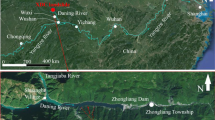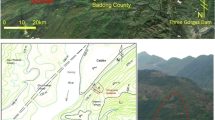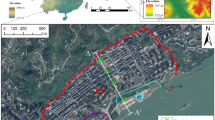Abstract
Xiluodu hydropower station is located on the Jinsha River, the upper course of the Yangtze River, and is the third largest hydropower station in the world. In May 2013, impoundment of the Xiluodu Reservoir started and preliminarily operation began, and the reservoir area was subject to frequent landslides and collapses. On 23rd July 2013, Huangping landslide, with a volume of 20 × 104 m3, slid into the Xiluodu Reservoir and generated an impulse water wave that killed 12 people on the opposite bank. The reservoir water level will fluctuate by 60 m each year, between the elevations of 540 and 600 m, so any impulse wave generated by a landslide in the reservoir is a major concern in the preliminary impoundment phase. Ganhaizi landslide is the biggest landslide in Xiluodu Reservoir, with a volume of about 7,800 × 104 m3. This landslide is only 14 km upstream from the Xiluodu Dam. In particular, the landslide deformation has obviously intensified after impounding. This paper analyzes the terrain and deformation features of Ganhaizi landslide, and we propose that sliding on the Ganhaizi slope may occur at the front part of the landslide. The front part of landslide has a volume of around 300 × 104 m3; the elevation of the barycenter of this part is 510 m. The sliding mass is thus largely underwater, and can pose a threat mainly in the form of surges. Based on the underwater landslide terrain in the mountain reservoir area, the authors have modified the seabed landslide-generated surge source model of Grilli and Watts (2005) to form an initial source model for an underwater landslide-generated surge. Using this model, the authors predicted possible surge disasters that can be caused by a Ganhaizi landslide at both the dead water level of 540 m and the normal water level of 600 m in Xiluodu Reservoir. The surge disaster might mainly strike the area within 5 km along the river channel both upstream and downstream of the landslide area, but generally poses no threat to Xiluodu Dam. This paper aims to provide technical support for the safety of Xiluodu Dam and the reservoir area. The newly established underwater landslide-generated surge initial source model for mountain reservoir areas may serve as reference for calculation of underwater landslide in other reservoir areas around the world.











Similar content being viewed by others
References
Akgün A (2011) Assessment of possible damaged areas due to landslide-induced waves at a constructed reservoir using empirical approaches: Kurtun (North Turkey) dam reservoir area. Nat Hazard Earth Syst Sci 11:1341–1350
Ataie-Ashtiani B, MalekMohammadi S (2007) Near field amplitude of subaerial landslide generated waves in dam reservoirs. Dam Eng 17(4):197–222
Ataie-Ashtiani B, Malek-Mohammadi S (2012) Mapping impulsive waves due to subaerial landslides into a dam reservoir: a case study of Shafa-Roud Dam. Dam Eng XVIII(3):1–25
Bosa S, Petti M (2013) Shallow water numerical model of the wave generated by the Vajont landslide. Environ Model Softw 26:406–418
Chengdu Hydroelectric Investigation and Design Institute of CHECC (CHIDI) (2009) Jinsha River Xiluodu Hydropower Station Reservoir bank stability comprehensive research report. Chengdu, China
Crosta GB, Imposimato S, Roddeman D (2013) Interaction of landslide mass and water resulting in impulse waves. Landslide sci pract 5:49–56
Deng HY, Wang CH (2011) Geological engineering character and mechanism analysis on ancient landslides in Xiluodu reservoir. Chin J Water Soil Conserv 2011(5):61
Enet F, Grilli ST (2007) Experimental study of tsunami generation by three-dimensional rigid underwater landslides. J Waterw Port Coas Ocean Eng 133:442–454
Enet F, Grilli ST, Watts P (2003) Laboratory experiments for tsunamis generated by underwater landslides: comparison with numerical modeling. In: Proceedings of 13th offshore and polar engineering conference. Honolulu, pp 372–379
Fan ZJ, Wang Z (2013) Analysis on the deformation behaviour of Ganhaizi landslide after impoundment of Xiluodu Reservoir. Chin J Geol Hazard Control 24(2):38–43
Grilli ST, Watts P (2005) Tsunami generation by submarine mass failure. Part I: modeling, experimental validation, and sensitivity analysis. J Waterw Port Coast Ocean Eng 131:283–297
Huang BL, Yin YP, Chen XT, Liu GN, Wang SC, Jiang ZB (2014) Experimental modeling of tsunamis generated by subaerial landslides: two case studies of the Three Gorges Reservoir, China. Environ Earth Sci 71:3813–3825
Igwe O, Mode W, Nnebedum O, Okonkwo I, Oha I (2014) The analysis of rainfall-induced slope failures at Iva Valley area of Enugu state, Nigeria. Environ Earth Sci 71:2465–2480
Lan HX, Qi S, Faquan W (2001) Nonlinear dynamic modeling on Ganhaizi landslide near Xiluodu hydropower station. Chin J Xiangtan Min Inst 16(3):5–11
Li M, Fan Z, Huang Z (2012) Study of Ganhaizi slope stability based on fuzzy information optimization. Chin J Yangtze River 43(1):41–46
Müller L (1964) The rock slide in the Vajont valley. Rock Mech Eng Geol 2(3–4):148–212
Norwegian Geotechnical Institute (NGI) (2005). Offshore geohazards—summary report for research institution-based strategic project 2002–2005. NGI Report No. 20021023-2
Prior DB (1984) Subaqueous landslides. Proc IV Int Symp Landslides Tor 1:179–196
Vanneste M, Forsberg CF, Glimsdal S, Harbitz CB, Issler D, Kvalstad TJ, Løvholt F, Nadim F (2011) Submarine landslides and their consequences: what do we know, what can we do? Proceedings of the Second World Landslide Forum, Rome
Walder JS, Watts P, Sorensen OE, Janssen K (2003) Tsunamis generated by subaerial mass flows[J]. J Geophys Res 18(B5):2236–2255
Walder JS, Watts P, Waythomas CF (2006) Mapping tsunami hazards associated with debris flow into a reservoir. J Hyd Eng ASCE 132(1):1–11
Wang FW, Zhang YM, Huo ZT, Matsumoto T, Huang BL (2004) The July 14, 2003 Qianjiangping landslide, Three Gorges Reservoir, China. Landslides 1:157–162
Watts P, Grilli ST, Tappin D, Fryer GJ (2005) Tsunami generation by submarine mass failure. Part II: predictive equations and case studies. J Waterw Port Coast Ocean Eng 131:298–310
Zhuang JQ, Cui P, Peng JB, Hu KH, Iqbal J (2013) Initiation process of debris flows on different slopes due to surface flow and trigger-specific strategies for mitigating post-earthquake in old Beichuan county, China. Environ Earth Sci 68:1391–1403
Zou GQ, Zhang S (2011) On stability of the Ganhaizi landslide of the Xiluodu hydropower station. Chin J Acta Geologica Sichuan 31(3):347–352
Acknowledgments
This study was financed by the National Natural Science Foundation of China (ID: 41372321) and the National Key Technology R&D Program (ID: 2012BAK10B01). Additionally, we would like to extend our thanks to friends from Xiluodu Construction Department of the Three Gorges Engineering Construction Corporation, who have brought us to field investigation and provided us with relevant data.
Author information
Authors and Affiliations
Corresponding author
Rights and permissions
About this article
Cite this article
Yueping, Y., Bolin, H., Shichang, W. et al. Potential for a Ganhaizi landslide-generated surge in Xiluodu Reservoir, Jinsha River, China. Environ Earth Sci 73, 3187–3196 (2015). https://doi.org/10.1007/s12665-014-3619-5
Received:
Accepted:
Published:
Issue Date:
DOI: https://doi.org/10.1007/s12665-014-3619-5




